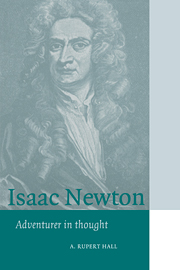Book contents
- Frontmatter
- Contents
- List of Figures
- General Editor's Preface
- Foreword
- Acknowledgement
- 1 The Hopeful Youth, 1642–1664
- 2 “The prime of my age for invention”, 1664–1667
- 3 Widening Horizons, 1667–1669
- 4 The Professor of Mathematics, 1669–1673
- 5 Publication and Polemic, 1672–1678
- 6 Life in Cambridge, 1675–1685
- 7 The Chemical Philosopher, 1669–1695
- 8 The Mathematical Principles of Natural Philosophy, 1679–1687
- 9 Private and Public life, 1685–1696
- 10 Fluxions and Fury, 1677–1712
- 11 Opticks, or a Treatise of Light, 1687–1704
- 12 Life in London, 1696–1718
- 13 A Man of Authority and Learning, 1692–1727
- 14 Later Books, 1706–1726
- 15 Kensington, 1725–1727
- Appendices
- Notes
- Bibliography
- Index
11 - Opticks, or a Treatise of Light, 1687–1704
Published online by Cambridge University Press: 12 January 2010
- Frontmatter
- Contents
- List of Figures
- General Editor's Preface
- Foreword
- Acknowledgement
- 1 The Hopeful Youth, 1642–1664
- 2 “The prime of my age for invention”, 1664–1667
- 3 Widening Horizons, 1667–1669
- 4 The Professor of Mathematics, 1669–1673
- 5 Publication and Polemic, 1672–1678
- 6 Life in Cambridge, 1675–1685
- 7 The Chemical Philosopher, 1669–1695
- 8 The Mathematical Principles of Natural Philosophy, 1679–1687
- 9 Private and Public life, 1685–1696
- 10 Fluxions and Fury, 1677–1712
- 11 Opticks, or a Treatise of Light, 1687–1704
- 12 Life in London, 1696–1718
- 13 A Man of Authority and Learning, 1692–1727
- 14 Later Books, 1706–1726
- 15 Kensington, 1725–1727
- Appendices
- Notes
- Bibliography
- Index
Summary
On the first of March, 1704, David Gregory noted in his diary that Newton had been ‘provoked by Dr Cheyns book to publish his Quadratures, and with it, his Light & Colours, &c.’ And just one month later Newton indeed signed and dated his “Advertisement” to this volume. Some sixteen months had passed since he had promised ‘Mr [Francis] Robarts, Mr Fatio, Capt. Hally & me to publish his Quadratures, his Treatise of Light, and his treatise of the curves of the 2d Genre [sic]’. In the interval Robert Hooke had died, thus clearing the way for the publication of Opticks,a book which Newton had sworn to keep to himself so long as Hooke lived. Opticks, like the pair of mathematical treatises that was to appear with it, had been long anticipated by Newton's friends. In 1694 Gregory had examined its three Books – hence it was substantially complete then, though Newton was not yet ‘fully satisfied about a certain kind of colours and the way of producing it’ – and summarized it in his diary of his visit to Cambridge (5 to 7 May). Newton meant to publish it after leaving the university, in English as it was written, or translated into Latin if he remained at Cambridge. By April 1695 John Wallis at Oxford knew of it (through Flamsteed's protégé Caswell) as ‘a Treatise about Light, Refraction and Colours’ already completed. ‘Tis pitty it was not out long since. If it be in English (as I hear it is) let it, however, come out as it is; & let those who desire to read it, learn English.’ Thus spoke this fervid Englishman! Through successive letters Wallis continued to prod Newton, but he would not budge.
- Type
- Chapter
- Information
- Isaac NewtonAdventurer in Thought, pp. 279 - 293Publisher: Cambridge University PressPrint publication year: 1996



